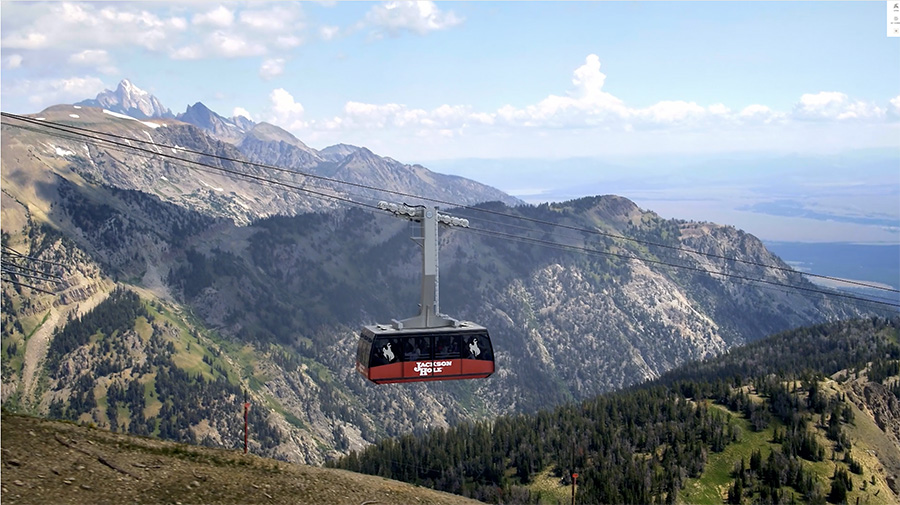For the sixth consecutive month, the booking pace for DestiMetrics* 17 participating mountain destinations in seven western states reached its longest downward streak since the onset of the pandemic.
The most recent data released by DestiMetrics parent Inntopia in its monthly Market Briefing revealed that, despite some recovery in financial markets and economic indicators, bookings for summer vacations remained stable, while bookings from international visitors entering the U.S. from Canada, Western Europe, and Mexico continued to decline.
The Average Daily Rate (ADR) for resort rooms increased by 2.0 percent in May, while occupancy declined by 0.7 percent compared to the same time last year. However, the lower booking pace in May reversed the positive upward year-over-year occupancy trend for the entire summer. As daily rates for the entire summer rose by an aggregate of 3.7 percent, overall occupancy shifted from a favorable position at the end of April to a 1.2 percent decline by May 31.
Sluggish Summer Bookings
The overall booking pace during May for the full summer was down 7.1 percent.
Bookings from Canada are down 55.5 percent, while those from Western Europe are down 35.5 percent. And, for the first time in months, there is a decline from Mexico of 5.4 percent. Domestic bookings are up just 1.7 percent.
After several post-pandemic summers with consistent year-over-year growth, occupancy for the upcoming summer is sluggish, although higher rates are helping to offset those losses for lodging properties. July occupancy is down 5.1 percent, August is down 0.9 percent, and September is down 4.7 percent.
“The financial and political turbulence of the past few months continues to have an impact on bookings—even with some good economic news and an uptick in consumer confidence during May,” explained Tom Foley, senior vice president of Business Intelligence for Inntopia. “The Memorial Day weekend, the unofficial kick-off to the summer season, was pretty ‘so-so’—as expected, but the larger concern now is that the two busiest months of the summer—July and August, are clearly underperforming.”
The Role of Economic News
After three tumultuous months, the Dow Jones Industrial Average (DJIA) reversed direction and closed on May 31 up 1,600 points, or 3.9 percent, as investors responded to an easing in trade tensions between the U.S. and China. Strong corporate earnings contributed to the surge, but the Dow remains 5.9 percent lower than its recent high of 44,910 in December 2024.
The Consumer Confidence Index (CCI), released by the Conference Board, revealed a positive reaction to market news, rising 12.3 points to 98 points (14.4 percent), representing an improvement from the five-year low of 87.7 points recorded in April.
Confidence improved across all income, age, and political affiliation groups. In contrast, the Consumer Sentiment Index (CSI) from the University of Michigan remained unchanged at 52.2 points, marking the first time in four months that it reported a decline. Respondents to both surveys reported being more optimistic about trade with China, but they also expressed ongoing concerns about wages and future inflation.
The latest data on unemployment and jobs was mixed, as the Unemployment Rate remained unchanged at 4.2 percent. However, job creation slowed notably, with only 139,000 new jobs added in May. Additionally, job creation numbers for the two previous months were adjusted downward, with March going from 185,000 to 120,000 and April dropping from 177,000 to 147,000. However, wages also continued to outpace inflation, now up 3.9 percent in a year-over-year comparison.
Consumer prices increased by 0.1 percent in May, and inflation rose from 2.3 to 2.4 percent, the first increase in the national inflation rate since January.
“There is some evidence that tariff costs are being passed to consumers but drops in energy and some commodities like vehicles and apparel have helped offset some of those daily consumer costs,” noted Foley. “The good news for the travel industry is that thus far, consumers are paying appreciably less to get to their destinations this summer as gasoline prices and airfares are down significantly from last year at this time and are helping to offset the higher costs of lodging.”
Keeping An Eye On It
Holidays are not performing as well, as the Memorial Day weekend arrived with year-over-year occupancy increases of less than one percent for the three nights of the weekend. And despite high expectations for the days before and after the July 4th weekend, bookings are currently lagging behind last year’s levels, except Friday, July 4, which is up 2.8 percent, and July 5, which is up 2.1 percent. All other dates between July 1 and 11 are down and have been declining.
Economy properties edged up in May as the luxury category struggled in a reversal of the past several months. Economy properties priced up to $250/night have slightly increased rates while also boosting occupancy and, in turn, improving revenue. This was the only category to record a strengthening in either occupancy or revenues. Moderately priced properties, priced at $251 to $400 per night, decreased their rates slightly but did not improve occupancy, resulting in softer revenues as of May 31. The luxury tercile, charging $401/night and above, raised their rates by 1.4 percent, resulting in a 3.2 percent drop in occupancy.
“The most notable conclusion from this month’s data is the undeniable impact that rate is having on bookings,” stated Foley. “Consumers are more price sensitive than they were during the peak inflation surges in the immediate post-pandemic period. We’re seeing a clear pattern that just about every time that year-over-year daily rates rise at all, the booking pace declines—and on the rare occasions that rates have dropped, those dates pick up bookings,” Foley continued.
Foley went on to observe that “the mountain lodging industry appears to be shifting to a philosophy of quality over quantity, choosing to attract fewer guests but targeting those willing to pay a bit more to drive revenue–while sacrificing the higher customer volume. And this may be a solid, if not the only approach available right now,” he elaborated. “So, as the volatility continues and consumers remain cautious as they await what impact tariffs will have on inflation, lodging properties will have to continue with diligent and balanced rate management and re-visit past successes with value-added strategies,” he concluded.
*DestiMetrics, part of the Business Intelligence platform for Stowe-based Inntopia, tracks lodging performance in resort destinations. Each month, forward-looking reservation data is compiled and aggregated, providing individualized results for each region, which are distributed monthly to subscribers at participating resorts. Approximately 28,000 lodging units in 17 mountain destination communities across Colorado, Utah, California, Nevada, Wyoming, Montana, and Idaho contribute to the data pool, representing an aggregated 55 percent of all available rental units in those regions. Results may vary significantly among and between resorts and participating properties.
Image courtesy Jackson Hole Mountain Resort
















